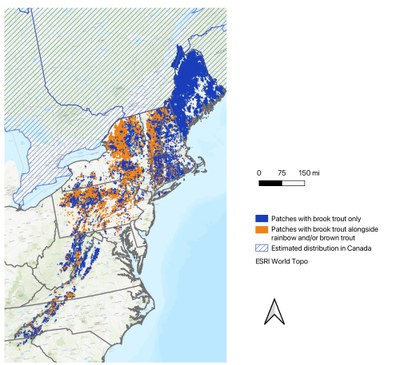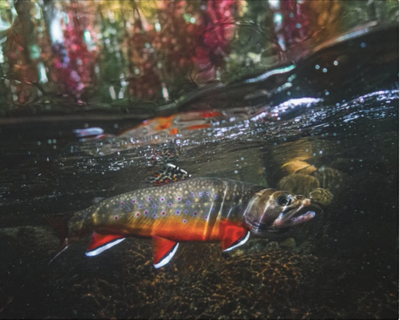Reflections on Brook Trout Conservation over the past 6 years
As I step down from the role of chairman of the steering committee of the Eastern Brook Trout Joint Venture, I want to share some thoughts on the state of brook trout conservation from a perspective that I’ve gathered over the past 6 years.
There are challenges for sure. There have been small, isolated populations of eastern brook trout that have disappeared. Extirpated, or locally extinct, is the technical term. Human development pushes on in some of our nation’s most populated corridors and fastest growing communities, which typically results in the loss of forests and increases impervious pavement. The climate is changing, more so in some regions than others, but generally we are facing warmer summers, more intense and frequent storms, and more severe droughts. Outside of Maine and a few river systems across a handful of other states, brook trout populations exist in largely small headwater populations, in many cases, physically and genetically isolated from other brook trout populations. In all states, brook trout have lost habitat where waters are too warm, are occupied by competing non-native fish, or both. Research indicates that percent forest cover is the most significant determinant of wild brook trout presence, with a threshold of generally 70% serving as the minimum for them to survive in a watershed.
But despite these realities, the state of the eastern brook trout remains relatively strong, and looking back six years I am relatively optimistic, and here’s why:
Many of the 17 states that form the core of the EBTJV have recently updated or amended their brook trout management plans, or they are in the process of doing so. These management plans have elevated the importance of brook trout conservation. Most states have eliminated the stocking of hatchery fish on top of wild brook trout populations. Many states have designated high quality eastern brook trout fisheries that have special management regulations to protect these fish, and to improve and promote recreational fishing opportunities there, including Maryland, Tennessee, Rhode Island, Connecticut, West Virginia, Virginia, New Jersey, New York, Tennessee. The state of Maine passed a regulation several years ago banning the use of bait on hundreds of their heritage wild brook trout ponds and lakes to protect these fish from non-native fish introductions.
I would argue that resource managers across the eastern range are more focused on the conservation of wild brook trout and the expansion of recreational fishing opportunities for them than ever before.
"the pace of habitat conservation projects and programs focused on eastern brook trout conservation is accelerating and the scope of the positive impact is growing."
If the EBTJV has done one thing for eastern brook trout, it has been to underscore and communicate the importance of aquatic habitat connectivity for the long-term survival of wild brook trout populations. We know that dollar for dollar, reconnecting aquatic habitat is often the most cost-effective way to expand brookie populations, give them access to headwaters to spawn and find cold water, and allow fish to travel downstream to big waters to find food and grow, and repopulate headwaters after damaging floods. Collectively the conservation community has taken this message and run with it.
And so the pace of habitat conservation projects and programs focused on eastern brook trout conservation is accelerating and the scope of the positive impact is growing. The EBTJV annually supports 3-6 brook trout habitat enhancement projects of several hundred thousand dollars (go to www.easternbrooktrout.org/projects for details), and most of these projects are culvert replacements and dam removals. But this is just the tip of the iceberg – there are literally dozens of brook trout aquatic connectivity projects happening every year across the range. Let’s note the fact that eastern brook trout have been designated by the multi-agency Chesapeake Bay Program as one of the key indicators of the health of the Chesapeake Bay, which involves a monumental effort and millions of dollars to improve the health of the headwaters of the much beloved Bay basin. Brook trout are the conservation focus of many National Forests, 9 if we are counting, and the highly skilled and dedicated fish biologists, hydrologists and engineers are collaborating with state agencies, federal highways administration, groups like Trout Unlimited and local watershed groups to plan, design and construct 10-20 projects a year where brook trout are the prime conservation target. The US Fish & Wildlife has funneled millions of dollars a year to support fish passage and stream restoration projects for brook trout. National Park Service units like Great Smoky Mountain National Park are managing streams to protect and reintroduce eastern brook trout. The National Fish & Wildlife Foundation has designated eastern brook trout as a priority species or priority conservation outcome, and awards millions and millions of dollars per year through a number of grant programs for a wide variety of agricultural, abandoned mineland reclamation, stream and habitat restoration and forest protection projects that benefit brook trout. The aquatic habitat connectivity restoration work is literally growing like a mushroom across the eastern range.
The other big win for eastern brook trout that strikes me is the expansion of the large wood addition instream habitat work. The benefits of building logjams, chopping and dropping trees, and adding logs to floodplains has been fully vetted by the research scientists and the EBTJV, trainings and workshops have been funded and expanded, and many states like Vermont, New Hampshire, Maine, New York, Pennsylvania, West Virginia, Virginia, Georgia now fund projects, support their own work crews or collaborate with Trout Unlimited programs and the Forest Service to add wood to miles and miles of brook trout streams.
The EBTJV deserves a lot of credit for this upwelling of support for eastern brook trout over the years. The scientific assessment of eastern brook trout led by the EBTJV in 2008 made the big splash that showed across the eastern range, brook trout populations had diminished considerably from their historic waters. That really put eastern brook trout on the forefront of so many state and federal managers’ minds. Over time, we refined the subwatershed-based assessment of brook trout populations to smaller catchments and connected populations, or patches. These higher res maps are at the foundation of TU's Eastern Brook Trout Conservation Portfolio and are central to prioritizing many on-the-ground conservation projects today.

It’s no surprise really that the EBTJV has remained strong and vibrant since its inception in 2004 as one of the nation’s first National Fish Habitat Partnerships, which now total 20 separate entities. The EBTJV has always been driven by the best available brook trout science. The Joint Venture is comprised of the fisheries “conservation rock stars” from 17 states, who live and breathe brook trout, and the nation’s top eastern brook trout scientists. The top research scientists from huge federal agencies like the Forest Service, the National Park Service, the US Fish & Wildlife Service and US Geological Survey, who have literally dedicated their careers to investigating and better understanding the physiology, habitat preferences, genetics, interactions with non-native species, impacts of climate change, growth and survival and more! But the bottom line is, the brook trout keep surprising us, with their ability to persist in small, headwater populations, their distinct genetic diversity among populations, and the confirmation that Southern Appalachian brook trout populations have lived in some streams for several million years. While our increased research on brook trout may yield even more questions, I would argue there are more bright minds than ever investigating all manner of topics related to Salvelinus fontinalis.
 (photo by Devin Davenport, @appalachian.trout)
(photo by Devin Davenport, @appalachian.trout)
And let’s celebrate the fact that brookies are cool. The constituency for eastern brook trout has grown, and with the mushrooming of social media and the platforms like Instagram and Twitter where anglers can show off the brook trout’s incredible charisma and mesmerizing beauty, more and more people are exposed to fish’s captivating qualities. There are breweries brewing special blends to honor the clean water environs of the brook trout, artists crafting colorful renditions, and underwater photographers documenting footage at a growing pace. More than ever, wild brook trout are emblematic of those clear, cold creeks and forested watersheds we all need for clean water, for recreation and a quieted soul, and for the benefit of all the downstream critters that depend on healthy headwaters. And they are becoming the face of coldwater environments, increasingly recognized evermore precious and threatened as the atmosphere and our waters warm. EBTJV and the larger brook trout advocacy community have done a fantastic job in making the direct link of healthy brook trout and the forested watersheds they require to other important and rare species like the hellbender, many species of imperiled freshwater mussels, even warblers.
As a network, the EBTJV seems poised for continued growth as state DOTs like Vermont, New York, Massachusetts and West Virginia are adopting fish friendly culvert design criteria driven in large part by brook trout advocates. Conservation of brook trout is driving organizations with professional staff and highly motivated and engaged volunteers like Trout Unlimited, Western Pennsylvania Conservancy, State Audubon and Nature Conservancy Chapters, Sportsman Alliances and land trusts, the list is much larger.
Let’s keep the message going and the projects and funding flowing!
Nat Gillespie, January 20, 2023
Document Actions





